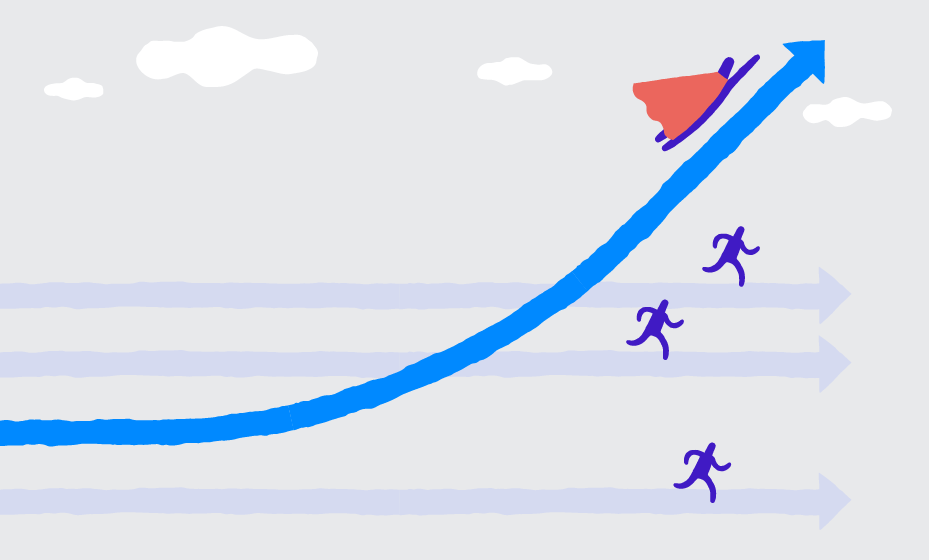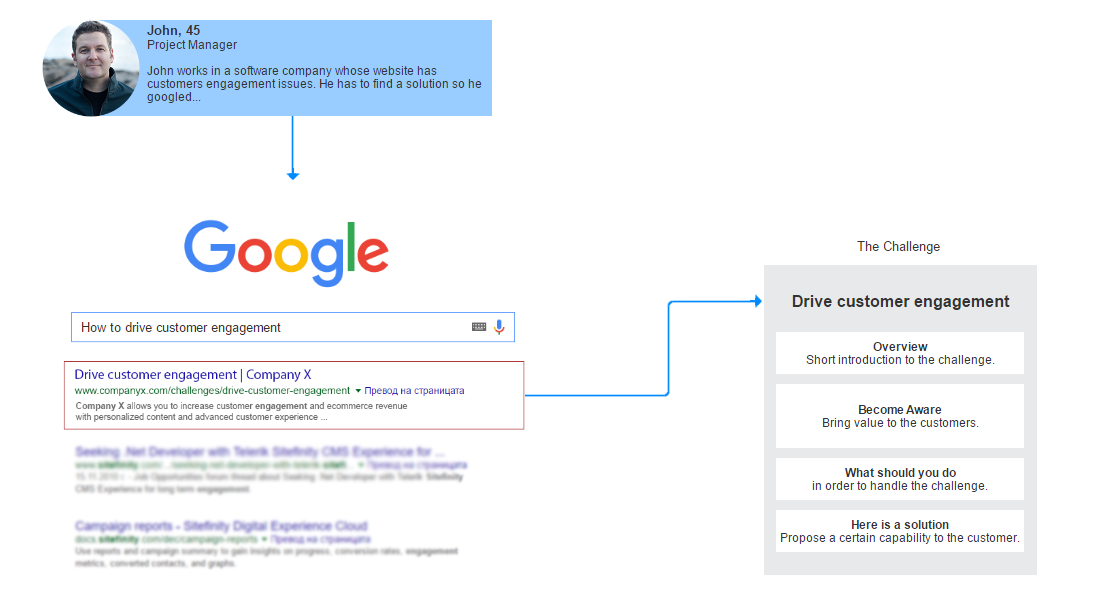The Challenge-Capability Model: A More Engaging Way to Present B2B Software

The B2B buyer has evolved drastically in the past few years. In the digital era that we live in, the B2B buyer is more informed, confident and independent than ever. According to Corporate Executive Board, 60% of the average B2B buyer’s purchase decision has already happened before approaching the supplier sales rep. Customers dedicate a significant part of their time during the decision-making process to research what they are buying in advance online, therefore the product’s online presence is vital to the end result.

The Challenge-Capability Model (CCM) is an approach to presenting software products online. Tailored to B2B software selling and marketing trends, the CCM helps companies develop an effective and highly engaging web-based user journey. Moreover, the CCM is specifically developed and designed to be applicable to a diversity of audiences, as well as to support B2B customers throughout the whole buying process—Awareness, Evaluation and Decision.
But before I dive deeper into CCM, let me tell you a story. Once upon a time in the ‘80s, something revolutionary emerged in the world of sales—the so-called “solutions selling approach.” With this sales methodology, sales reps would discover the buyers’ needs or pain points, usually by asking the customer questions or researching the customer in advance, and then sales reps would combine/adapt their software solutions to best meet and fit the customer’s needs.
The world has changed a lot since the 1980s, and customers no longer rely on the sales reps to provide them with the solutions they are looking for. In fact, if you’ve done any sales in recent years, you have probably already heard that solution selling is terminally ill. B2B buyers now use online sources, experienced procurement teams and sophisticated purchasing consultants to define their needs and find the solutions themselves.
Reflecting this new B2B reality, there are new selling methodologies like Insight Selling and Challenger Sale, which echo the current B2B buyer behavior. All of them aim to:
- Educate customers on the new business challenges in their industry
- Share business-relevant research, observations and hypotheses with customers
- Focus on what customers’ competitors are doing
- Challenge customers with disruptive insights, urging them to think differently and driving them outside their comfort zone toward the solution they really need
The CCM philosophy is based on the approaches described above, and adapts them for the web. But what does the Challenge-Capability Model actually look like? It's a web journey consisting of two main parts: the challenge and the capability.

A simple example of CCM information architecture. Of course, it's possible that multiple capabilities of your software will be needed to address a single challenge. Conversely, the opposite may be true as well—many challenges to be handled by one capability.
Assuming that both the Challenge and the Capability can be presented in the web journey through a separate page, or set of pages, the CCM would be something like this:
The Challenge
Simply put, the Challenge is where you meet the customer.
No management team wakes up in the morning and makes the decision to purchase a software platform for no reason. Every company faces its own challenges on the road to positive development and growth. If, for some reason, the company is not aware of the challenges it is facing or the opportunities it is missing, this is where we come in to uncover them, break the ineffective patterns and show the customer the better way.
Although challenge triggers can be very different depending on the customer, here are a few practical examples:
|
Triggers that May Cause Buyers to Start Evaluating Software Solutions |
Examples |
|
Acquisition |
Need to merge all different software products |
|
Budget optimization |
Centralization of assets for budget optimization |
|
Change of management |
New management prefers the previous technology they used |
|
Outgrown existing solution |
Current solution doesn't have the necessary features or doesn't integrate with other systems |
|
Rebrand |
Current solution may not be the best solution to support customers’ new business goals |
|
Change of business model |
Customers sell offline and decide to start selling or marketing online |
|
New regulations |
Customers need to comply with new regulations and can't with existing technology |
|
Obsolete technology |
Customers can't no longer find support for current solution |
After we have explored some common examples of the challenges a customer is facing, let's take a closer look at a sample use case of the Challenge webpage:

The Challenge webpages are your "hooks" for the customer's challenges.
This is what the simple information architecture of the Challenge looks like:
Introduction
The introduction includes a title and short description of the challenge the customer is facing. It's crucial that the title of this page corresponds to the exact wording that customers would use when they search for a solution online.
Become Aware
This section is a key element of the CCM. This is where create awareness among customers by educating them about the challenges they face and inspiring them with insights on their businesses. You can enhance this section by adding some supplementary resources, for example: Analytics Reports.

How to create a business insight
Overall, in this section, you show the customers that you are the thought leader in their field and they can trust you completely.
What Should You Do?
Here, you provide the customers with recommendations on what they should start doing in order to handle their challenge.
The Solution
In this section, propose and drive customers to a particular capability of your software that can handle the challenge described above.
The Capability
The Capability is your response to the customer's challenge.
The definition of the term capability (in regard to software) is, "the power or ability to generate an outcome." This is exactly what this stage is about.
In this phase, you need to present and describe in the best possible way how the capabilities you offer answer the challenges that customers face. As you present your capability, it is crucial that you avoid focusing on the technical specifications and instead look at its actual advantages when implemented. Here is an example of a capability that has gained lot of popularity recently—experience personalization. If you tell customers how personalization works, what it can do, etc., you will lose momentum. Instead, you should tell customers about the real power of personalization when applied, how it can lift the burden off employees’ shoulders and bring more conversions to businesses.

A sample structure of a Capability webpage
Overview
It includes the title of the capability and a short description.
How Does It Work?
Very often, customers are not that interested in the technical side of a capability’s incredible features, but rather in its practical application and outcomes. It is quite intuitive for sales reps to try to impress customers with the "WOW" features of its product, but they need to place special emphasis on customer outcomes. You must educate customers about how the solution works and, correspondingly, how the product will handle their challenges.
Therefore, a good approach would be comparing the capability's outcomes with the customer's current practices and focusing on how it will improve and perfect them.
Selling Propositions/Competitive Advantages
This section is pretty self-explanatory—you should look to include a list of key accents and features of your capability, which represent its strengths and its exemplary traits.
Credibility
This is where you can brag about your product. For example, you can show some real-life implementations of specific capabilities that helped other customers flourish. This brings credibility and authority to your business and your offerings.
Features
Nevertheless, you should include some details of the capability you’re offering. When designing for a B2B website, you must support a long, complex buying cycle with all the necessary information. The capability page would normally be visited by the so-called user persona, who are the actual users of the capability and would like to learn more about its technical specifics.
Clear Next Steps
Provide the customer with clear next steps towards the purchase. For example, “talk to an expert,” “request a demo,” “download your free trial,” etc. However, you also need to make sure there are options available for people who are not quite ready for purchase. You can drive them to your pricing pages, additional success stories or other resources in order to support the decision-making process.
Conclusion
In conclusion, we can say that the CCM is able to facilitate a content strategy that is much more scalable. This is due to the fact that you can release new and fresh content in the form of challenge pages, which will keep you in the loop of what is new in the world of B2B.
The Challenge-Capability Model is not a new process of selling software products online, but it is an approach that builds a user web journey that is far more engaging for users and at the same time provides them with much more value in a more practical way. It's an approach that helps you better connect to your customers' needs and support them as they face their challenges. Plus, CCM is flexible enough to be applied to different spheres of business and customer communities.
![[684a4f23-5482-43bb-bb75-5e328aeeb6e7]Daniel-Stoyanov](https://www.progress.com/images/default-source/blogs/blog-authors/-684a4f23-5482-43bb-bb75-5e328aeeb6e7-daniel-stoyanov.jpg?sfvrsn=69106ceb_6)
